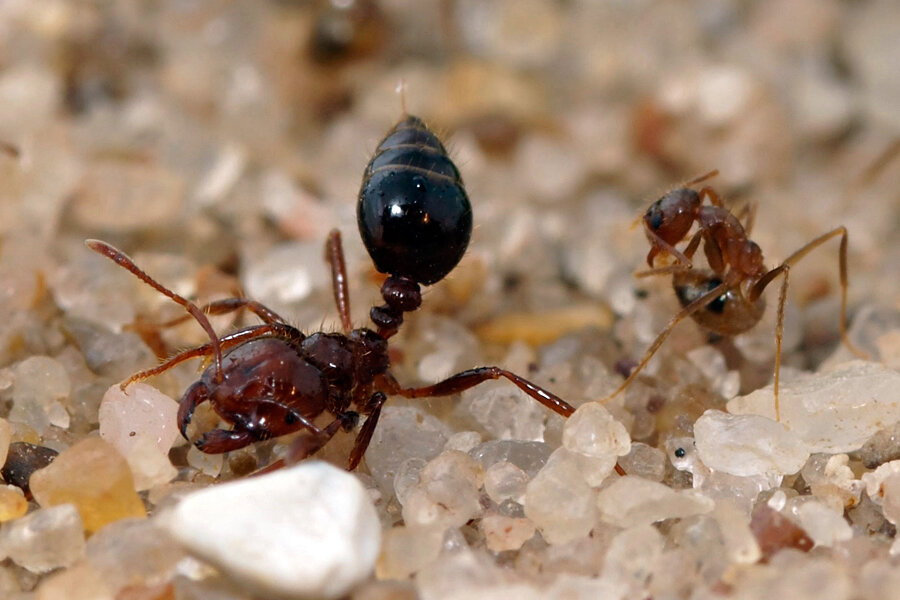Why 'crazy ants' can hold their own in fights with notorious fire ants
Loading...
Most ants about to cross paths with the US Southeast's notorious fire ants would have to be crazy to foment turf wars with the stinging pests.
But one species – called none other than tawny crazy ants – has no qualms about mixing it up with fire ants. In a new study, scientists have uncovered the reason: Crazy ants drenched in venom have a unique ability to briefly retreat, secrete then wash themselves with a detox agent, and race back into the fray.
For anyone stung by fire ants, the prospect of another invasive species – with a milder bite – replacing them might seem attractive.
But the crazy ants, first discovered in Texas in 2002, already have developed a reputation for invading homes, even appliances within homes, or anywhere else with nooks and crannies suitable for nests. They can disrupt home electrical systems when they nest between walls. When exterminators come, they remove spritzed ants by the dustpan-load.
Fire ants at least have the decency to nest and roam outdoors.
Beyond the annoyance to humans, however, the arrival and spread of crazy ants could bring lasting changes to the mix and abundance of other insects that a range of creatures higher up the food chain rely on, researchers say.
At the University of Texas' Brackenridge Field Laboratory in Austin, researcher Edward LeBrun was examining the ecological effects of crazy-ant invasion. Others had noted that once crazy ants arrive, fire ants seem to vanish from the scene.
"Fire ants are very tough competitors," says Dr. LeBrun, who focuses his research on invasive species. They are abundant ahead of an advancing front line of large populations of crazy ants. But 200 yards behind the advancing front of crazies, "the fire ants are just gone. It happened fairly rapidly."
To see how the two types of ants interact, he set out cricket bait in the no-ant's land between the two populations, where only a relatively few ants of each type wandered. When fire ants reached the bait first, a cricket would soon be covered in 300 to 400 of them.
Normally, he says, most other ants sensing food and the presence of fire ants would keep clear. Crazy ants, on the other hand, would charge into the massed fire ants to assume ownership of the cricket.
LeBrun says he also noticed that during the ensuing melee, when a fire ant flicked venom from the rear end of its abdomen onto a crazy ant, the crazy ant would back off, double over, and use its mouth to extract a substance from the end of its abdomen. It would then use its forelegs to retrieve the substance from its mouth and rub it over the rest of its body.
Was this chemical-warfare detox on the battlefield? To find out, LeBrun and two colleagues at the field laboratory brought back groups of each type of ant.
They set up confrontations between the two types, with crazy ants divided into two groups: one whose outlets at the back end of their abdomens were blocked by nail polish; the other whose outlets were unclogged, but instead wore the nail polish on the sides of their abdomens.
Some 48 percent of the crazy ants with the clogged outlets died after fire ants daubed them with venom. Ninety-eight percent of the crazy ants with the unclogged outlets survived the daubing from fire ants.
Additional work showed that the compound that the crazy ants used to detox themselves was formic acid, the same fluid that they use as their own chemical weapon to overcome the fire ants. The results of the crazy-ant detox study are set to appear in Friday's issue of the journal Science.
The researchers aren't sure why the acid works as a detox agent. One possibility: It disrupts enzymes in the fire-ant venom that break down cells in other insects' crusty exoskeletons, a process that would allow the toxins to reach victims' vital organs.
Both fire ants and crazy ants appear to have evolved together in South America, in the generally warm and humid climates of northern Argentina and southern Brazil. That makes the US Southeast feel like home, LeBrun suggests.
When fire ants first landed in Mobile, Ala., in the 1930s, their populations were dense, a condition that has eased over time, he notes. Even so, these ants significantly reduced the number of lizards, snakes, and other small reptiles in areas they overran.
"We don't yet know what crazy ants will do," he says. "There will be winners and losers." Based on research results released last year, however, on balance crazy ants are likely to deliver a bad deal as they eat their way through many organisms at the bottom of the food chain.








